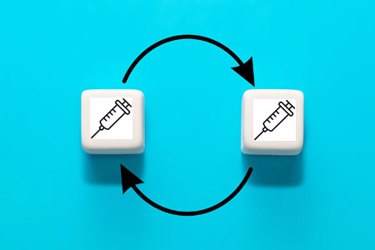Biosimilar Interchangeability: Regulatory & Practical Considerations
By Liese Barbier, Yannick Vandenplas, Teresa Barcina Lacosta, and Arnold G. Vulto, KU Leuven Belgium Research Group on Best-Value Biologicals

After the expiry of patents and other market exclusivities of originator biological medicines, similar versions with proven equivalent clinical outcomes, i.e., biosimilars, are allowed to enter the market. Biosimilars receive marketing authorization based on a comprehensive comparability exercise, demonstrating high similarity in terms of efficacy, safety, and immunogenicity profile.1,2 The robustness of their regulatory evaluation is confirmed by positive in-market experience and reassuring results in switching studies, showing that there is no reason to assume that switching from an originator biological to its biosimilar would lead to differences in clinical outcomes.3,4 However, even after 15 years of positive experiences with biosimilars and a solid EU biosimilar pharmacovigilance track record,2,5 one of the remaining issues still dominating the debate is whether or not biosimilars can be considered interchangeable with their reference biological product6 or with biosimilars of the same reference product. In recent years, several scientific papers have been published discussing biosimilar interchangeability.
Interchangeability has different implications across the world, depending on which regulatory or legal framework applies.6 In general, interchangeability refers to the possibility of exchanging one medicine for another with the same clinical effect. This implies replacing the reference biological product with its biosimilar (or vice versa) or exchanging biosimilars of the same reference product with each other. Such a replacement can occur at two different levels: by the prescribing physician (i.e., switching or transitioning) or by the pharmacist (i.e., substitution).2 Here, we provide an up-to-date overview of regulatory and practical considerations regarding biosimilar interchangeability with an emphasis on the European perspective.
Interchangeability: Different Meanings Across Jurisdictions
The European Medicines Agency (EMA) has no official position or recommendation on the interchangeability of biosimilars, as prescribing practices and advice to prescribers fall within the remit of the individual member states. In Europe, a biosimilar that has been authorized according to stringent regulatory requirements of the EU biosimilar approval pathway may be considered interchangeable,7,8 but it is up to the individual member states to set out prescribing and dispensing practices related to interchangeable use. So, in general, switching and substitution practices across Europe depend on national legislation or recommendation.1,6,9 This has led to a large variety in the guidance of national competent authorities across Europe. Surprisingly, only a limited number of national agencies have a formal position on biosimilar interchangeability and switching.10 While, when available, positions vary between agencies in terms of content and extent, several agencies (e.g., the Netherlands, Finland) have provided clear statements regarding the possibility of interchanging biosimilars under the supervision of the physician.10 Indeed, switching a reference biological with its biosimilar, or vice versa, under the supervision of the prescriber has become a standard practice in most European member states. An exchange at the level of the pharmacy, i.e., biosimilar substitution, is currently not allowed or practiced for biological products in most countries in Europe.10
A different approach regarding biosimilar interchangeability applies in the United States. In the United States, interchangeability is legally defined in the Biologics Price Competition and Innovation Act of 2009 (BPCIA), and it is a matter of regulatory assessment. If a biosimilar receives interchangeability status, it may be substituted at the pharmacy level for the reference biological product without the intervention of the prescribing physician, if permitted by state laws.11 As outlined in FDA guidance to sponsors, the interchangeability designation requires additional clinical data involving two or more alternate switches between a biosimilar and its reference product.12 However, it must be made clear that a designation of interchangeability is unrelated to the biosimilar product’s quality, safety, and efficacy, which are established during biosimilar evaluation. It is rather an additional assessment toward regulating interchangeable use that would enable substitution by the pharmacist. An interchangeability designation is in essence only relevant for products dispensed in the retail or specialty pharmacy setting, where automatic substitution could be applicable.13 To date, only two products have been granted the interchangeability designation in the U.S. (Semglee, an insulin glargine biosimilar, and Cyltezo, an adalimumab biosimilar), but there may be more to follow. The arrival of interchangeable biosimilars may have an impact on the competitive landscape, as once introduced in the market (e.g., adalimumab, 2023) these products may become the preferred products over other biosimilars.
Other large markets or regulatory authorities have also developed their positions regarding the interchangeability of biosimilar products. One of the countries that has developed a clear position on interchangeability is Australia. The Australian Pharmaceutical Benefits Advisory Committee (PBAC) evaluates biosimilars on their interchangeability case by case. Biosimilars can be “a-flagged,” which means automatic substitution is allowed.6 Several biosimilars have already been provided with this status and can be substituted at the pharmacy-level. The Pharmaceuticals and Medical Devices Agency (PMDA) of Japan does not take a particular position regarding interchangeability. However, pharmacy-level substitution is not allowed by law in Japan. Other major Asian markets such as China, South Korea, and India have also developed their own regulations regarding biosimilar medicines in recent years. However, their regulatory framework does not yet address biosimilar interchangeability.6
Misconceptions And Confusion In The Debate
As outlined above, the scientific and regulatory meanings of the term interchangeability are different depending on the geographical scope. These differences in terminology and regulatory approaches between jurisdictions may be confusing for healthcare providers and other stakeholders in the field. For instance, the FDA interchangeability designation may be incorrectly interpreted as a higher quality standard than biosimilarity in itself,13 instilling doubts regarding the safety, efficacy, and quality of biosimilars that have not received an interchangeability designation. In Europe, the scattered landscape regarding biosimilar interchangeability and switching guidance may suggest a lack of regulatory agreement and scientific endorsement of switching.10 To eliminate confusion regarding the interchangeable use of biosimilars, there is a need for harmonized scientific switching and biosimilar interchangeability guidance in Europe, which can inform unambiguous guidelines per country.10,14 In addition, when discussing interchangeability with healthcare professionals, it is essential to position the discussion in the correct geographical context to avoid misinformation and confusion.
Immunogenicity: A Cause For Concern In Biosimilar Interchanging?
One of the main concerns raised in the context of the biosimilar interchangeability is the suggested risk for immunogenicity arising from a switch between non-identical but highly similar biological medicines.1,7,9 However, according to regulatory opinion, the theoretical basis for such a risk is weak. For biosimilars approved according to rigorous regulatory standards, which excludes products with inferior quality coming to market, it is highly unlikely that harmful immunogenicity would be triggered by a switch.7,9,15
In 2015, in Finland, The Finnish Medicines Agency (FIMEA) provided an in-depth position on biosimilar interchangeability, addressing concerns about triggering immunogenicity with a switch.15 As explained in this statement, the risk of switch-related immunogenicity events is unlikely to be greater than the risk of switching between different batches of biological medicine.15 In line with this, the EMA stated in its 2017 biosimilar guidance to healthcare professionals that “there is no reason to believe that harmful immunogenicity should be expected after switching between highly similar biological medicines.”2 In a recent publication (2021), Kurki et al. present a comprehensive analysis of pre- and post-licensing safety data, as well as immunogenicity and interchangeability data of all EMA-licensed biosimilar monoclonal antibodies and fusion proteins up to August 2020. The authors concluded that the concerns for increased immunogenicity upon switching these well-studied products are unfounded.8
A review published by Strand et al. (2020) summarized immunogenicity data for biosimilars in rheumatic diseases, plaque psoriasis, and inflammatory bowel disease.16 The study assessed the incidence of anti-drug antibodies (ADAs), which are a known measure of immunogenicity, and established the effect of switching on the incidence of ADAs. It was concluded that in terms of ADA incidence and the effect of ADAs on clinical parameters, the reference products and the corresponding biosimilars induce a similar immunological response. Indeed, data collected for adalimumab, etanercept, infliximab, and rituximab indicated that biosimilar interchangeability does not result in changes in quantitative or qualitative immunogenicity.
Practical Considerations
A point of practical consideration when exchanging subcutaneous biological medicines is the fact that the delivery device may vary between products. When switching to a subcutaneously self-administered product, it should be warranted that patients receive proper biosimilar interchangeability guidance from a healthcare provider to ensure appropriate use with a possibly new injection device.1,9,17
In Europe, switching takes generally place under the supervision of the prescribing physician. Any considerations regarding product administration can be dealt with in such a setup. In settings where products are substitutable at the level of the pharmacy, counselling by the pharmacist will be required.
In Australia, the PBAC takes elements that could affect the easiness of substitution by the pharmacist into account when evaluating biosimilar interchangeability on a product-by-product basis. This may include, for example, the strength of formulation and the number of units per product pack. When evaluating possible differences in auto injectors for adalimumab and etanercept biosimilars, PBAC noted that these were “likely to be minor and can be managed through the regular patient education and counselling on the use of the devices that is provided to patients by prescribers and pharmacists.”18 The effect of the injection device was also evaluated in the recent Kurki analysis (2021) and confirmed the Australian position.8
Besides counselling patients regarding their injection device, healthcare professionals must be well informed and confident regarding biosimilar use to minimize the nocebo effect. The nocebo effect, the negative counterpart of the placebo effect, can be described as a negative subjective treatment outcome, such as worsening of side effects or lowered perceived product efficacy, because of negative treatment expectations.19 Several studies pointed toward the impact of the nocebo effect to explain the sometimes higher discontinuation rates than anticipated in patients who switched to a biosimilar.1,3 The nocebo effect should be mitigated via healthcare professional education and appropriate patient communication strategies.19,20 The possible differences in injection devices between products and the need for mitigation strategies of the nocebo effect may point toward the need for physician involvement when exchanging a reference product with its biosimilar.1 In Australia, however, the substitution for biologicals has been effectively implemented at the pharmacy level by PBAC evaluation of product exchange feasibility on a product-by-product basis. 6
In Europe, rather than a matter of scientific debate, hurdles to allow for the substitution of biologicals may exist on political, practical, and organizational levels.17,21 While automatic substitution for biologicals is generally not allowed or practiced across Europe, a few countries have made or are preparing legislative changes to implement it:
- In Germany, the substitution of biosimilars was already possible, but only limited to substituting “bioidenticals” or “duplicates,” i.e., biosimilars made by the same manufacturer that have been licensed under a different brand name. More recently, a new legal framework has been introduced in the context of the Gesetz für mehr Sicherheit in der Arzneimittelversorgung (GSAV), or law for more safety in the supply of pharmaceuticals, broadening the application of automatic substitution of biologicals beyond bioidenticals.22 The German Statutory Health Insurance (G-BA) is responsible for translating this into practice and offers two sets of guidance: one for physicians with details on how to switch and one for pharmacists, providing a positive list of biosimilars eligible for automatic substitution. The change is planned to come into effect in 2022.22
- In Norway, the possibility for automatic substitution of biologicals is being considered, with the national medicines agency proposing that the Pharmacy Act § 6-6, which forms the basis for generic pharmacy substitution, should be changed to allow automatic substitution of new medicines including biologicals.23,24,25 To allow pharmacy-level substitution, community pharmacists should receive the necessary training to adequately counsel patients with such a change and possible differences in injection devices.17
Conclusion
Regulatory guidance on interchangeability differs among jurisdictions. The different meanings and usage of terminology regarding interchangeability lead to confusion among clinicians. A clear and unified regulatory position regarding biosimilar interchangeability is important to appropriately inform healthcare professionals and clinical practice.10 Therefore, harmonization of position statements relative to the interchangeability of biosimilar medicines is necessary. One of the remaining concerns of clinicians regarding interchangeability is the risk of increased immunogenicity after transitioning. However, there are no data to substantiate the theoretical risk of immunogenicity when switching from a reference biological to its biosimilar and, as such, these concerns are considered unfounded. The body of clinical evidence and theoretical considerations reassure that biosimilars approved according to robust regulatory standards are interchangeable. In order to implement interchangeability in clinical practice, clinicians should be properly educated on how to use new injection devices and mitigate possible nocebo effects. The involvement of healthcare professionals during an exchange, as well as guaranteeing an educated shared decision-making process, is paramount to successfully translating biosimilar interchangeability into practice. With all the current evidence taken into consideration, we concur with Ebbers and Schellekens;1; we can close the scientific debate: the final hurdles for interchangeability of innovator products and biosimilars are not of a scientific but rather practical nature.14
References
- Ebbers HC, Schellekens H. Are we ready to close the discussion on the interchangeability of biosimilars? Drug Discov Today. 2019;24(10):1963–7.
- European Medicines Agency and the European Commission. Biosimilars in the EU - Information guide for healthcare professionals. 2017.
- Barbier L, Ebbers H, Declerck P, Simoens S, Vulto A, Huys I. The efficacy, safety and immunogenicity of switching between reference biopharmaceuticals and biosimilars: a systematic review. Clin Pharmacol Ther. 2020;108(4):734–55.
- Cohen HP, Blauvelt A, Rifkin RM, Danese S, Gokhale SB, Woollett G. Switching Reference Medicines to Biosimilars: A Systematic Literature Review of Clinical Outcomes. Drugs. 2018;78(4):463–78.
- Vermeer NS, Giezen TJ, Zastavnik S, Wolff-holz E, Hidalgo-simon A. Identifiability of Biologicals in Adverse Drug Reaction Reports Received From European Clinical Practice. Clin Pharmacol Ther. 2019;105(4).
- Rathore AS, Stevenson JG, Chhabra H, Maharana C. The Global Landscape on Interchangeability of Biosimilars. Expert Opin Biol Ther. 2021;
- Kurki P, van Aerts L, Wolff-Holz E, Giezen T, Skibeli V, Weise M, et al. Interchangeability of Biosimilars: A European Perspective. BioDrugs. 2017;31(2):83–91.
- Kurki P, Barry S, Bourges I, Tsantili P, Wolff-Holz E. Safety, Immunogenicity and Interchangeability of Biosimilar Monoclonal Antibodies and Fusion Proteins: A Regulatory Perspective. Drugs. 2021;81:1881–96.
- O’Callaghan J, Barry SP, Bermingham M, Morris JM, Griffin BT. Regulation of biosimilar medicines and current perspectives on interchangeability and policy. Eur J Clin Pharmacol. 2019;75(1):1–11.
- Barbier L, Mbuaki A, Simoens S, Declerck P, Vulto A, Huys I. Regulatory Information and Guidance on Biosimilars and Their Use Across Europe: A Call for Strengthened One Voice Messaging. Front Med. 2022;9:820755.
- McKinley L, Kelton JM, Popovian R. Sowing confusion in the field: the interchangeable use of biosimilar terminology. Curr Med Res Opin. 2019 Apr;35(4):619–21.
- Woodworth TG, Den Broeder AA. Treating to target in established rheumatoid arthritis: Challenges and opportunities in an era of novel targeted therapies and biosimilars. Best Pract Res Clin Rheumatol. 2015;29(4–5):543–9.
- Cohen HP, McCabe D. The Importance of Countering Biosimilar Disparagement and Misinformation. BioDrugs. 2020;34(4):407–14.
- Barbier L, Vulto AG. Interchangeability of Biosimilars: Overcoming the Final Hurdles. Drugs. 2021;81(16):1897–903.
- Fimea. Interchangeability of Biosimilars – Position of Finnish Medicines Agency Fimea. 2015.
- Strand V, Gonçalves J, Hickling TP, Jones HE, Marshall L, Isaacs JD. Immunogenicity of Biosimilars for Rheumatic Diseases , Plaque Psoriasis , and Inflammatory Bowel Disease : A Review from Clinical Trials and Regulatory Documents. BioDrugs. 2020;34(1):27–37.
- Tolonen HM, Airaksinen MSA, Ruokoniemi P, Hämeen-anttila K, Shermock KM, Kurki P. Medication safety risks to be managed in national implementation of automatic substitution of biological medicines : a qualitative study. BMJ Open. 2019;9.
- PBAC. Public Summary Document – July 2018 PBAC Meeting. 2018.
- Kristensen LE, Alten R, Puig L, Philipp S, Kvien TK, Antonia M, et al. Non ‑ pharmacological Effects in Switching Medication : The Nocebo Effect in Switching from Originator to Biosimilar Agent. BioDrugs. 2018;32(5):397–404.
- Vandenplas Y, Simoens S, Van Wilder P, Vulto AG, Huys I. Informing Patients about Biosimilar Medicines: The Role of European Patient Associations. Vol. 14, Pharmaceuticals. 2021.
- Barbier L, Simoens S, Vulto AG, Huys I. European Stakeholder Learnings Regarding Biosimilars: Part II — Improving Biosimilar Use in Clinical Practice. BioDrugs. 2020;34:797–808.
- Delgado M. Biosimilar Automatic Substitution In The EU5: Current State & Future Outlook [Internet]. Biosimilar Development. 2019. Available from: https://www.biosimilardevelopment.com/doc/biosimilar-automatic-substitution-in-the-eu-current-state-future-outlook-0001
- Medicines for Europe. Positioning Statements on Physician-led Switching for Biosimilar Medicines [Internet]. 2020. Available from: https://www.medicinesforeurope.com/wp-content/uploads/2017/03/M-Biosimilars-Overview-of-positions-on-physician-led-switching.pdf
- Ministry of Health and Care Services. Consultation - proposal for amendments to the Pharmacy Act § 6-6 [Internet]. [cited 2021 Jun 4]. Available from: https://www.regjeringen.no/no/dokumenter/horing---forslag-til-endringer-i-apotekloven--6-6/id2721390/?expand=horingsbrev
- Norwegian Ministry of Health and Care Services. Prop. 84 L (2020–2021) Changes in the Medicines Act and the Pharmacy Act (change of biological medicines in pharmacies). 2021.
About The Authors:
The authors are part of the research unit Clinical Pharmacology and Pharmacotherapy, at the Department of Pharmaceutical and Pharmacological Sciences, KU Leuven (Catholic University Leuven), Belgium. Dr. Liese Barbier, Teresa Barcina Lacosta, and Yannick Vandenplas are post-doctoral/PhD researchers at KU Leuven. Prof. Arnold G. Vulto is honorary professor at KU Leuven as well as Emeritus Professor at Erasmus MC in Rotterdam, The Netherlands.
 |
 |
 |
 |
The research group, in collaboration with the Erasmus University Medical Center, established in 2016 a research program exploring the market environment of biologics, including biosimilars following loss of exclusivity, called the MABEL Fund. The research activities of the MABEL group aim to study market dynamics for originator biologics, biosimilars, and second-generation biologics and to investigate the evolution of strategies for market access and uptake of these products in Europe. Various Ph.D. researchers explore these aspects over an extended period of time, allowing the group to investigate the effects of a changing market environment and to evaluate how these changes may affect the long-term sustainability of the off-patent biologics and biosimilars marketplace. For more information about the MABEL Fund, visit here and here.
